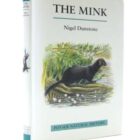
A report from the town of Verona reveals building blueprints (and more). See selected images below, or download the whole report here.

Several credible studies have been published over the years showing that ranch-raised mink both survive and thrive in the wild.
To add to this discussion, here are several quotes taken from the rare book The Mink (Dunstone), further supporting this.
On domestication claims:
“The fact that escapee animals so readily adapt to alien countryside, and to differing species of pray and climatic conditions, indicates that man’s…
This one-time “hub” of Aleutian disease research may no longer experiment on mink. As recently as 2004, USDA records indicate Utah State had 200 mink, presumably the research subjects of fur industry researcher LeGrande Ellis, who was (is?) studying a threat to fur farmers only eclipsed by animal rights activists: Aleutian disease. Recent USDA reports do not list mink as among the animals killed at the school. Here’s a quote about the work that was being done at USU: “A vaccine is being developed against the disease by Utah State University that promises to eliminate these losses, which could save Utah mink producers $2.4 million.” (USDA, 2003) The small amount of information available on mink at U.S.U. specified that they were held at the “North Logan Farms” research station, a satellite research facility located about a mile north of the main campus. If you have any solid information on whether fur industry research is still happening at Utah State University, please submit to Coalition Against Fur...
The reputed science journal Nature published a 2001 article on the suffering of fur farmed mink. The article concludes that mink kept in cages suffer from lack of access to water the same way they suffer from lack of access to other necessities, such as food. Some quotes from the article: “Our results indicate that fur-farmed mink are still motivated to perform the same activities as their wild counterparts, despite being bred in captivity for 70 generations”. “…in the wild (mink) would patrol territories 1–4 km long, use several nest sites, and hunt by following scent trails, investigating burrows, and diving and swimming for aquatic prey.” “The high level of stress experienced by mink denied access to the pool, rated as the most valuable resource, is evidenced by an increase in cortisol production indistinguishable from that caused by food deprivation. These results suggest that caging mink on fur farms does cause the animals frustration, mainly because they are prevented from swimming.” Despite arguments that mink housed in fur farms have successfully adapted to captivity, these animals may suffer by being deprived of resources that exist in the wild.” Frustrations of Fur-farmed...
Coalition Against Fur Farms obtains new issue internal fur industry newsletter Fur Farm Letter CAFF has obtained copies of the Fur Farm Letter, published by the Fur Commission USA. We will be publishing numerous excerpts from the newsletters over the coming weeks. For now, we are posting this article by mink veterinarian John Easley. We chose this article as the first to be released because it is very relevant to previous posts this week regarding information CAFF is uncovering about mink vaccine research. Several important things are gleamed from this article: *The fact that the Fur Commission USA lobbied for this meeting with Merck further emphasizes how significant it’s vaccine is. *The research facility outside Omaha (see posts from earlier this week) is” Merck Animal Health’s main research and development and production facility for the majority of their vaccines that they distribute worldwide”. *Quote: “The Merck representatives continually reinforced that the mink vaccine production is very important to them.” *Quote: “Merck has only has one source for their test animals”. As covered in a post earlier this week, this is likely to be Steve Krage / Circle K Farms in Sioux City, Iowa (near Omaha). *There is a vaccine shortage, which is of concern to US fur farmers. *Notice this quote: “Merck has done a lot of work investigating why they are having the problem and have made changes with the way they manage their test mink population at the farm and in the lab”. This indicates the mink research is being done in an experimental farm setting. It is not known if this is on-site, at the Sioux City farm, or elsewhere. *United Vaccines in Wisconsin “hopes” to have a “4-way vaccine available for the North American market in about 18 months.” Here is the article, in full: Fur Commission meets with Merck Vaccine Producers Fur Farm Letter, Spring 2012 By Dr. John Easley DVM, Fur Commission USA Director of Research After attempting to arrange a meeting for months, this February we were able to organize a meeting with Merck Animal Health for mink industry representatives. Kate Roesler, FCUSA Board Member from the state of Washington representing the US producers, Peter Peters from...